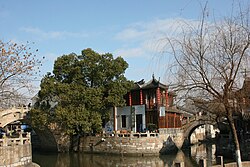This article needs additional citations for verification. (May 2011) |
Jinshan
金山区 Kinshan | |
|---|---|
 Fengjing Ancient Town | |
 | |
 Jinshan in Shanghai | |
| Country | People's Republic of China |
| Municipality | Shanghai |
| Area | |
| • Total | 586.14 km2 (226.31 sq mi) |
| Population (2020) | |
| • Total | 822,776 |
| • Density | 1,400/km2 (3,600/sq mi) |
| Time zone | UTC+8 (China Standard) |
| Postal code | 200540 |
| Area code | +86 (0)21 |
| Website | https://en.jinshan.gov.cn/ |
| Jinshan, Shanghai | |||||||||||
|---|---|---|---|---|---|---|---|---|---|---|---|
| Traditional Chinese | 金山區 | ||||||||||
| Simplified Chinese | 金山区 | ||||||||||
| Postal | Kinshan | ||||||||||
| Literal meaning | Gold Mountain District | ||||||||||
| |||||||||||

Jinshan District, is a suburban district of southwestern Shanghai, neighboring Zhejiang province and Hangzhou Bay. It has a land area of 586.14 square kilometers (226.31 sq mi) and a population of 732,500 as of the 2010 Chinese census.[1] Jinshan District, located in the southwest of Shanghai, is one of the biggest districts of the city. Local political administration is divided into nine towns and one subdistrict. About 6.2 kilometers (3.9 mi) off the coast of Jinshan, there are three islands named Dajinshan ("Big Gold Mountain"), Xiaojinshan ("Little Gold Mountain"), and Fushan ("Floating Mountain"). At 103 meters (338 ft) above sea level, the peak of Dajinshan Island is the highest point within the Shanghai municipality. There are several beaches along the 23.3-kilometer (14.5 mi) shoreline, which are popular tourism destinations.
As the city of Shanghai has grown, Jinshan has experienced rapid changes, evolving from a relatively rural area to a more suburban environment. With completion of the high-speed highway in 2008, a new bus line was opened between Shanghai and Jinshan. This Shimei Line (t 石梅線, s 石梅线) travels between the bus station in Jinshan and another beside the Jinjiang Park station on Line 1 of the Shanghai Metro. Travel time is about an hour, depending on traffic and time of day, and costs 10 RMB each way.
Since 2012, the Shanghai Suburban Railway system also offers connections to Jinshan. This service, the Jinshan Railway, connects Jinshanwei railway station to Shanghai South railway station in downtown Shanghai in about 30 minutes.
The district is home to the Donglin Temple, a Buddhist temple dedicated to Guanyin, the bodhisattva of compassion. Jinshan peasant painting, which originated in the town of Fengjing, has become a nationally and internationally exhibited form of folk art.[2]
- ^ 1.
- ^ Huancheng Guo; Guozhu Ren; Mingwei Lü (2007). Countryside of China. Beijing: China Intercontinental Press. ISBN 978-7-5085-1096-5.